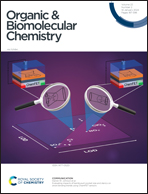Electronic effects of conjugated aryl groups on the properties and reactivities of di(arylethynyl)tetracenes†
Abstract
The photochemical oxidations of acenes can cause challenges with their optoelectronic applications, such as singlet fission and organic transistors. At the same time, these reactions form the basis for many luminescent sensing schemes for 1O2. While diethynyl substitution is arguably the most widely adopted of the various substitution strategies to control oxidation and also improve solubility and processability of long acenes, the extent to which differences between the alkyne groups can influence key properties of long acenes remains largely unknown. This report therefore describes the effects of various arenes and heteroarenes on the electronic structures, optical properites, and reactivity with singlet oxygen for eight 5,12-di(arylethynyl)tetracenes. The fluorescence spectra of these tetracenes span approximately 100 nm, while their observed rate constants for reaction with singlet oxygen correlates strongly with the HOMO level, spanning one order of magnitude. They are also amenable to fluorescent materials that respond ratiometrically to singlet oxygen. Therefore, electronic effects of groups directly conjugated to ethynylacenes offer a useful chemical space for rational acene design.



 Please wait while we load your content...
Please wait while we load your content...